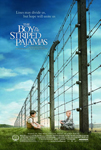2008
Main Movie
Page
Atonement
Boy in the Striped Pajamas
Brideshead Revisited
Counterfeiters
The Dark Knight
Enchanted
Frozen River
Indiana Jones and the Kingdom of the Crystal Skull
Iron Man
Juno
Man on Wire
Michael Clayton
No Country
for Old Men
Rachel Getting Married
the Savages
The Secret Life of Bees
Sweeney Todd
There Will Be Blood
The Visitor
WALL-E
Film
Reviews from 2007
Film Reviews
from 2006
The Boy in the Striped Pajamas
Gradually, Bruno begins to hear from his father, other soldiers, and his tutor, that the people in the camp are Jewish, who are called everything from “different” to “enemies of the state” and “less than human.” Bruno’s mother understands more than Bruno. Still she does not understand the full purpose of the concentration camp until a soldier tells her the nature of the stench from the thick smoke coming from the camp. Horrified, she argues with her husband, and eventually demands that Bruno and his sister Gretel be taken to a “safer” location.
I will not give away the ending, except to say that it is tragic and disturbing. I felt numb leaving the theater. Despite its moving elements, the film is problematic. I found the characters stereotypical and one-dimensional. The men are all staunch Nazis, while the women (with the exception of Gretel) question the party line. I also could not believe that Bruno’s frequent visits to Shmuel across the barbed wire went totally undetected. At one point, he is even able to dig under the wire and go into the camp. Finally, as disturbing as the ending is, I found it highly implausible. The authenticity of the film is severely hampered by the fact that many actors spoke with British accents. Was there no dialogue coach? Despite its problems, when it focuses on the unlikely relationship between
the two boys from different worlds, The Boy in the Striped Pajamas is
poignant. Their simple friendship across boundaries offers hope
in our world still torn by violence and hatred.
|
|
subscribe to
DomLife.org and receive a free email update every two weeks. unsubscribe |



 At the center of this new film, based on the novel by the same name
by John Boyne, is a friendship between two eight year old boys: Bruno,
the lonely son of a Nazi Concentration Camp Commandant, and Shmuel, a
Jewish boy in the camp. Bruno and his family have just moved from
Berlin to the large house on the edge of the camp, and Bruno does not
understand who the people are. Bruno thinks the camp that he glimpses
from his bedroom window is a farm, and wonders why the farmers all wear “striped
pajamas.” He thinks the numbers they wear on their shirts
are, somehow, part of a game.
At the center of this new film, based on the novel by the same name
by John Boyne, is a friendship between two eight year old boys: Bruno,
the lonely son of a Nazi Concentration Camp Commandant, and Shmuel, a
Jewish boy in the camp. Bruno and his family have just moved from
Berlin to the large house on the edge of the camp, and Bruno does not
understand who the people are. Bruno thinks the camp that he glimpses
from his bedroom window is a farm, and wonders why the farmers all wear “striped
pajamas.” He thinks the numbers they wear on their shirts
are, somehow, part of a game. In the meantime, driven by boredom and loneliness, Bruno escapes the
walls of his front yard, and finds his way to the edge of the camp. He
sees Shmuel, a boy on the other side of the barbed wire fence, and begins
to talk to him about his life in the camp. Bruno still does not
understand the nature of the camp or its Jewish prisoners. Bruno
begins to bring the emaciated Shmuel food, which he hands to him across
the wires. In the best scene in the film, Bruno is surprised to
find Shmuel in his house one day, cleaning the crystal. Shmuel
said that they needed someone with small hands for the task. Bruno
gives him a piece of cake. When a soldier sees Shmuel eating,
he accuses him of stealing the food. Shmuel says that Bruno is
his friend, and he gave the cake to Shmuel. When the soldier questions
Bruno, he panics, and claims that he’s never seen Shmuel before,
echoing Peter’s denial of Jesus. The next time Bruno sees
Shmuel across the barbed wire, he is badly bruised. Bruno apologizes,
saying he was frightened, and Shmuel accepts his apology. The two
remain friends.
In the meantime, driven by boredom and loneliness, Bruno escapes the
walls of his front yard, and finds his way to the edge of the camp. He
sees Shmuel, a boy on the other side of the barbed wire fence, and begins
to talk to him about his life in the camp. Bruno still does not
understand the nature of the camp or its Jewish prisoners. Bruno
begins to bring the emaciated Shmuel food, which he hands to him across
the wires. In the best scene in the film, Bruno is surprised to
find Shmuel in his house one day, cleaning the crystal. Shmuel
said that they needed someone with small hands for the task. Bruno
gives him a piece of cake. When a soldier sees Shmuel eating,
he accuses him of stealing the food. Shmuel says that Bruno is
his friend, and he gave the cake to Shmuel. When the soldier questions
Bruno, he panics, and claims that he’s never seen Shmuel before,
echoing Peter’s denial of Jesus. The next time Bruno sees
Shmuel across the barbed wire, he is badly bruised. Bruno apologizes,
saying he was frightened, and Shmuel accepts his apology. The two
remain friends.